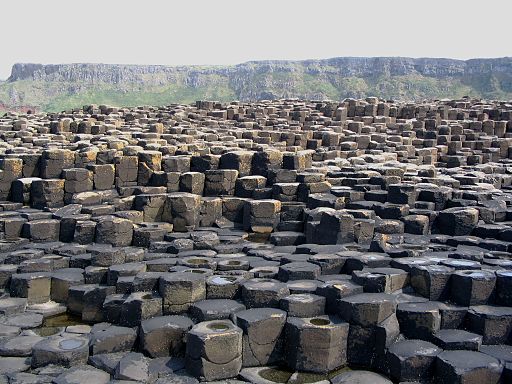If you are travelling to Northern Ireland, the chances are that you have already heard about the Giant’s Causeway. It is not only one of the main tourist attractions in the area, but also one of the greatest Natural Wonders in the entire United Kingdom. The Giant’s Causeway is by geographical definition, a natural formation of basalt columns that were formed roughly 60 million years ago as the direct result of a gigantic volcanic eruption in the area. It consists of over 40,000 columns (primarily hexagonal) with the tallest ones reaching heights of 10 – 12 meters. On the other hand, the lava base on the ridges run as deep as 30 meters or so at certain areas.
What makes the Giant’s Causeway most impressive and gives it its legendary name is the fact that the tops of these basalt formations resemble a series of stepping stones fit for a giant as they descend from the foot of the cliff and into the sea. In 1986, UNESCO declared it to be a World Heritage Site and in the following year, Department for the Environment of North Ireland marked it as a National Nature Reserve; thus ensuring protection from modernization for the foreseeable future.

The Legend Behind the Name
As you can probably guess, there is a legend behind the name and it is quite an interesting one. Legend has it that there was once an Irish Giant named Fionn mac Cumhaill or simply Finn MacCool. After being challenged by the Scottish giant called Benandonner, Fionn had built the Giant’s Causeway which stretched across the Northern Channel. This allowed the two gigantic beings to meet and duel it out to see who was the strongest. Now, there are two endings to this story and one of them is quite amusing.
The first ending depicts Benandonner being defeated by Fionn Cumhaill after a proper fight, but the second ending suggests that there was no fight. It is said that Fionn had come to know that the Scottish giant was significantly larger than him and thus decided to flee the duel. Fionn hid in the arms of his wife Oonagh, disguised as a baby. When Benandonner reached Oonagh and Fionn, he was shocked and scared to see how big the baby was. The terrified giant could only imagine how big the father of this “baby” would be and fled the battlefield. On his way back, he destroyed the causeway, to ensure that the Irish giant could not follow.
Although this is the primary Gaelic mythology behind the Giant’s Causeway, it is not the only one. Some Irish folklore suggests that Fionn mac Cumhaill was not a giant but a legendary hero. In this version, he also has superhuman abilities and may have been a member of the Fomorians (Fomhóraigh), who were gigantic beings of supernatural origin and abilities in popular pre-Christian Irish mythology. The exact stories and legends referring to that school of thought are lost in time though.
Discovery and Tourism
The Giant’s Causeway was originally discovered by the Bishop of Derry in 1692. However, the outside world came to know of its existence when Sir Richard Bulkeley of Trinity College, Dublin, submitted his work on the causeway to the Royal Society in 1693. The Causeway gained further and more widespread attention in 1739 after a series of famous watercolor paintings were done by an artist named Susanna Drury, that were later engraved in 1743. In the year 1765, Encyclopédie, the French encyclopaedia, published about the Giant’s Causeway but it was not until 1768 that it was recognized for the first time as a volcanic formation by French geologist Nicolas Desmarest in that year’s version of the Encyclopaedia.
The year 2012 marked a new beginning for tourism at the Giant’s Causeway as a visitor’s spot was once again opened after remaining inactive for 12 years since the last building was damaged by fire. The task was made possible with public donations, efforts and funds from the Northern Ireland Tourist Board, the National Trust and the Heritage Lottery Fund.
The natural marvel is not only beautiful and magnificent as a whole but it also has particular details to it that have become tourist favourites with Allen’s Tours. Such famous details include “The Giant’s boot,” “Giant’s Harp,” “Giant’s Eyes,” “The Chimney Stacks,” “The Shepherd’s Steps,” “Honeycomb,” “The Camel’s Hump” and “The Giant’s gates.” These shapes are the results of natural weathering for millions of years, but it is fascinating to see them resemble such shapes and often fuels one’s imagination.
If you are visiting Ireland, we suggest that you make the effort necessary to go and see the stones at Giant’s Causeway and witness the artistry of nature first hand.

